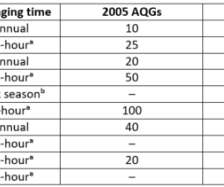WHO issues new, lower Global Air Quality Guidelines for classical pollutants
Green Car Congress
SEPTEMBER 25, 2021
When action is taken on these classical pollutants—particulate matter (PM), ozone (O?), PM is primarily generated by fuel combustion in different sectors, including transport, energy, households, industry, and from agriculture. and PM 10 ), ozone, nitrogen dioxide, sulfur dioxide and carbon monoxide. nitrogen dioxide (NO?)













Let's personalize your content